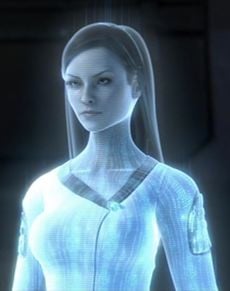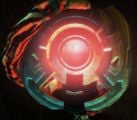Artificial Intelligence: Difference between revisions
From Halopedia, the Halo wiki
m (Undo revision 769410 by Cabursurulur (talk) Original wording better) |
No edit summary |
||
| Line 7: | Line 7: | ||
==Creation== | ==Creation== | ||
The process of creating an AI is different than most people realize. Instead of simply "programming" an AI, the AI matrix is actually created by sending electric bursts through the neural pathways of a [[human]] brain which are then replicated in a superconducting nano-assemblage. This destroys the original brain tissue however, and so the brain being used could only be obtained after the host had died. However, in some instances, as in the case of the | The process of creating an AI is different than most people realize. Instead of simply "programming" an AI, the AI matrix is actually created by sending electric bursts through the neural pathways of a [[human]] brain which are then replicated in a superconducting nano-assemblage. This destroys the original brain tissue however, and so the brain being used could only be obtained after the host had died. However, in some instances, as in the case of the A.I. [[Cortana (AI)|Cortana]], the candidate brain was flash-cloned and had its memories transferred to the receptacle organs so that the host, in this case [[Dr. Catherine Halsey]], could remain alive. | ||
It should be noted that [[Dr. Halsey]] supervised the creation of the template for every third-generation [["Smart" AI]] on the planet [[Reach]]. She has extensive knowledge on how AIs work. | It should be noted that [[Dr. Halsey]] supervised the creation of the template for every third-generation [["Smart" AI]] on the planet [[Reach]]. She has extensive knowledge on how AIs work. | ||
| Line 88: | Line 88: | ||
*[[Covenant AI]] | *[[Covenant AI]] | ||
*[[Monitor]] | *[[Monitor]] | ||
[[Category:Technology]] | [[Category:Technology]] | ||
[[Category:A.I.| ]] | [[Category:A.I.| ]] | ||
Revision as of 18:19, March 24, 2009

Artificial Intelligence, or A.I., was developed by the UNSC in cooperation with ONI. The first generation "Smart" AIs were believed to be developed in the 21st century.
Creation
The process of creating an AI is different than most people realize. Instead of simply "programming" an AI, the AI matrix is actually created by sending electric bursts through the neural pathways of a human brain which are then replicated in a superconducting nano-assemblage. This destroys the original brain tissue however, and so the brain being used could only be obtained after the host had died. However, in some instances, as in the case of the A.I. Cortana, the candidate brain was flash-cloned and had its memories transferred to the receptacle organs so that the host, in this case Dr. Catherine Halsey, could remain alive.
It should be noted that Dr. Halsey supervised the creation of the template for every third-generation "Smart" AI on the planet Reach. She has extensive knowledge on how AIs work.
Smart and Dumb AIs
Most AIs give themselves a unique appearance (otherwise known as an avatar) that corresponds to their main use. "Smart" AIs, or AIs that are not confined to their one purpose, have a normal operational life span of about seven years. Because the "Smart" AI is subject to an established memory core which cannot be replaced, the more the AI collects data, the less "thinking" space it has to work with. An AI literally "thinks" itself to death. Dumb AIs do not have this problem as they do not learn anything that is outside of their set limits of dynamic memory processing matrix. They are quite useful in their particular field of expertise, but very limited. Smart AIs can function and learn as long as they are active.[1]
The Cole Protocol states that capture of an AI by the Covenant is unacceptable. When in danger of capture, AIs are to be terminated and completely erased.
Rampancy

If a "smart" human AI exists for over 7 years, it usually enters a stage of rampancy similar to the Human state of insanity. The AI becomes to think that it is superior to its Human creators, and has delusions of godlike power.[2]
343 Guilty Spark, the Forerunner Monitor went rampant after Sgt. Johnson threatened to destroy the replacement for his Installation. This proves that AIs can go rampant when severely upset or threatened. Mendicant Bias went rampant, the Covenant AI in Halo: First Strike went rampant after it attacked Cortana, and Cortana herself went rampant for a time while imprisoned in High Charity.
Design
It is technically unclear exactly how an AI works, as it is only based on the functionality of a human brain, which UNSC scientists do not fully understand. AIs do not have physical bodies, rather they are advanced software consisting of a Riemann Matrix for higher-function processing. This matrix can be downloaded into a Data Crystal Chip for mobility. In case of Rampancy, the Riemann Matrix has a fail-safe program that will destroy the AI. Since AIs must be created by mapping out the connections of a Human brain, it seems likely that the UNSC does not have an understanding of how to create AIs from scratch, and is limited to simply "copying" the intelligence of biological organisms. In the real-world, this is an established possibility for creating artificial intelligence.
They can only take physical form where holographic technology is available. This requires a Holotank of some kind.
Because "Smart" A.I.'s are created using either actual Human brains or cloned Human brains there are often times residual thoughts, memories and/or feelings that remain. These residuals can be anywhere from the "feeling" of a hair brush being pulled through hair in the case of Sif or even have an effect on the mannerisms and characteristics that make up the personality of an A.I., in the case of Cortana and her likeness to Dr. Catherine Halsey.
Human AIs
Other than the two types "Dumb" and "Smart," Human AIs are given certain purposes. Over the course of a few hundred years, humans have developed a highly advanced understanding of this type of technology, and are capable of creating intelligent and nearly sentient "Smart" AIs. However, these beings are not the result of actual programming, they can only be created by "copying" a human intelligence, which is only possible by destroying the original brain. The most sophisticated of human AIs are sometimes considered to be comparable to known Forerunner AIs. Human Smart AIs have an "expiration" date of 7 years. Once they have reached this age, they will become very susceptible to rampancy, as has been demonstrated in the Insurrectionist AI Juliana. This time limit can (in theory) be prevented, or at least subdued, by having the AI focus on one thing. In the case of Juliana, the Rubble and its inhabitants. It is unknown whether this limitation is also apparent in Forerunner AIs, but it is unlikely. If this time limit did exist in Forerunner AIs, it would most likely be much longer than 7 years. The "7 years" is also another obvious reference to Bungie's favorite number.
Known Human AIs
- Araquiel - Colonel Ackerson's personal AI.
- Beowulf - Was the attaché to Admiral Michael Stanforth and the UNSC Navy.
- Cortana - CTN 0452-9 - UNSC Military AI (3rd Generation Smart)
- Deep Winter - AI formally in charge of Onyx.
- Déjà - Teacher - UNSC/ONI Dumb AI
- Doppler - MIL AI 8575 - UNSC Military AI
- Endless Summer - MIL AI 4279
- Eternal Spring - Was assigned to Onyx and the planetary survey team in the area of Zone 67.
- FitzGibbon - Was the ship-board AI of the UNSC Prophecy during the Second Battle of Harvest
- Jerrod - The first micro-AI.
- Kalmiya - Dr. Halsey's former personal AI, Cortana's "older sister".
- Lysithea - She was located in the UNSC High Command's headquarters, HighCom Facility Bravo-6 in Sydney, Australia.
- Melissa - UNSC/ONI AI
- Serina - Shipboard AI of UNSC Spirit of Fire.
- Solipsil - An ONI AI.
- Toran - Was a UNSC AI construct.
- Wellsley - UNSC Military - Dumb AI
- Sif - Colony AI/Special Operations.
- Mack - Colony AI/Agricultural Operations.
- Loki - Ship AI of UNSC Skidbladnir.
- Superintendent - New Mombasa Urban Infrastructure AI.
- Juliana - The Rubble's AI.
Forerunner AIs
As exemplified by the Monitors, the Forerunners have developed a civilization with an extremely advanced knowledge of artificial intelligence technologies. Forerunner AIs have managed to achieve full sentience and are highly intelligent.
The manner in which Forerunner AIs are created is unknown, yet is probably very different from the Human method of cloning the intelligence of a sentient organism. Monitors, and possibly other Forerunner AIs are physically represented by large, shielded and roughly spherical metallic "robots" whom possess a single "eye", which is possibly used to perceive the monitors physical surroundings. The most well known of Forerunner AIs are the protocol-obsessed Monitors, made famous by 343 Guilty Spark and his quirky (and somewhat unstable) nature.
Known Forerunner AIs
- 343 Guilty Spark - Monitor of Installation 04
- 2401 Penitent Tangent - Monitor of Installation 05
- Mendicant Bias - Wartime AI, betrayed the Forerunners
- Offensive Bias - Wartime AI, replacement for Mendicant Bias
Covenant AIs
So far only two types of Covenant AIs (Security and Naval) have ever been encountered within the universe. Their knowledge in this type of technology appears to be inferior to that of the UNSC and the Forerunner, as demonstrated by the fact that their AIs were most likely captured UNSC AIs, which were altered to fit within their theocratic society. In Covenant mythology it was a Forerunner AI that lead to the demise of the great Forerunner civilization by defecting to their enemies, the Flood. As a result, the Hierarchs of the Covenant imposed a ban on this sort of technology, a ban which has apparently been broken on more than one occasion. The ban may be an explanation for their less-developed understanding of artificial intelligences.[3]
Trivia
- Smart AIs enter rampancy after 7 years of operation. This could be a possible 7 reference.
Gallery
A Forerunner AI, 2401 Penitent Tangent, the Monitor of Installation 05
References
- ^ Halo: The Fall of Reach, page 235
- ^ "For a Smart AI, self-absorption invariably led to a deep depression caused by a realization that it could never really be human-that even its incredible mind had limits. If the AI wasn’t careful, this melancholy could drag its core logic into a terminal state known as rampancy, in which an AI rebelled against its programmatic constraints-developed delusions of godlike power as well as utter contempt for its more inferior, human makers. When that happened, there was really no option but to terminate the AI before it could do itself and others serious harm." Halo: Contact Harvest, page 31
- ^ Halo: First Strike
